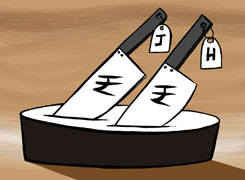Ramalingam Kalirajan |10881 Answers |Ask -Follow
Mutual Funds, Financial Planning Expert - Answered on May 27, 2024
He has an MBA in finance from the University of Madras and is a certified financial planner.
He is the director and chief financial planner at Holistic Investment, a Chennai-based firm that offers financial planning and wealth management advice.... more

Me 48 year ka hu aur sbi contra me 15000 aur sbi magnum tax gain me 5000 aur sbi small cap me 5000 aur sbi energy me 5000 ka sip chalu he 20 se 25 sal kya ye sahi he
Assessing Your Current Investment Strategy
You have chosen a diverse range of mutual funds, which is commendable. Diversification is essential for risk management and potential growth. However, evaluating each fund's role in your portfolio is crucial.
Understanding Your Investment Horizon
A 20 to 25-year investment horizon is excellent. It allows your investments to grow and recover from market volatility. Long-term investments benefit from the power of compounding, which is advantageous for wealth accumulation.
Evaluating Each Fund Category
Contra Funds
Contra funds invest in undervalued stocks, expecting them to perform well over time. These funds require patience and a long-term perspective. Your decision to allocate Rs 15,000 to a contra fund aligns well with your horizon. These funds can offer substantial returns if market predictions hold true.
Tax-Saving Funds
Investing Rs 5,000 in a tax-saving fund like an ELSS (Equity Linked Savings Scheme) is wise. These funds provide tax benefits under Section 80C of the Income Tax Act. Besides tax savings, ELSS funds offer potential for significant returns due to their equity exposure.
Small Cap Funds
Allocating Rs 5,000 to small cap funds shows a willingness to take on higher risk for higher returns. Small cap funds invest in smaller companies with high growth potential. These funds can be volatile but can offer substantial long-term gains. Considering your long-term horizon, this allocation can be beneficial.
Sectoral Funds
Investing Rs 5,000 in an energy sector fund demonstrates your interest in sector-specific growth. Sectoral funds can provide high returns but come with higher risks due to their concentrated investments. These funds depend heavily on the performance of the specific sector.
Balancing Risk and Return
Your portfolio shows a mix of high-risk, high-reward funds. This balance is suitable for long-term goals. However, it's essential to periodically review and adjust your allocations based on market conditions and personal circumstances.
Benefits of Actively Managed Funds
Active funds are managed by professional fund managers who make investment decisions based on research and market analysis. They aim to outperform the benchmark index. This active management can potentially offer better returns compared to passive funds, especially in a volatile market.
Disadvantages of Index Funds
Index funds track a specific market index and do not attempt to outperform it. They tend to offer average returns, which might not be sufficient for high growth objectives. In an actively managed fund, you benefit from the fund manager's expertise and potential to achieve higher returns.
Benefits of Regular Funds
Investing through a Certified Financial Planner (CFP) ensures you receive expert advice tailored to your financial goals. Regular funds, as opposed to direct funds, come with the advantage of professional guidance and strategic planning. This can be particularly beneficial for achieving long-term financial objectives.
Importance of Periodic Review
Regularly reviewing your investment portfolio is crucial. Market conditions and personal financial goals can change. A periodic review helps in realigning your investments to ensure they remain on track to meet your objectives.
Considerations for Future Adjustments
As you approach your financial goals, gradually shifting to less volatile funds can help protect your accumulated wealth. This strategy ensures that market fluctuations have minimal impact on your investment value as you near your goal.
Conclusion
Your current SIP strategy shows a well-thought-out approach to long-term investing. The mix of funds chosen reflects a good balance between growth potential and risk management. Periodic reviews and adjustments, along with professional guidance, will help in achieving your financial goals effectively.
Best Regards,
K. Ramalingam, MBA, CFP,
Chief Financial Planner,
www.holisticinvestment.in
You may like to see similar questions and answers below
Ramalingam Kalirajan |10881 Answers |Ask -Follow
Mutual Funds, Financial Planning Expert - Answered on Jul 11, 2024
Milind Vadjikar | Answer |Ask -Follow
Insurance, Stocks, MF, PF Expert - Answered on Apr 22, 2025
Reetika Sharma |423 Answers |Ask -Follow
Financial Planner, MF and Insurance Expert - Answered on Dec 02, 2025
Nayagam P P |10854 Answers |Ask -Follow
Career Counsellor - Answered on Dec 14, 2025
Radheshyam Zanwar |6744 Answers |Ask -Follow
MHT-CET, IIT-JEE, NEET-UG Expert - Answered on Dec 14, 2025
Radheshyam Zanwar |6744 Answers |Ask -Follow
MHT-CET, IIT-JEE, NEET-UG Expert - Answered on Dec 14, 2025
Dr Dipankar Dutta |1840 Answers |Ask -Follow
Tech Careers and Skill Development Expert - Answered on Dec 14, 2025
Dr Dipankar Dutta |1840 Answers |Ask -Follow
Tech Careers and Skill Development Expert - Answered on Dec 13, 2025
Dr Dipankar Dutta |1840 Answers |Ask -Follow
Tech Careers and Skill Development Expert - Answered on Dec 13, 2025
Mayank Chandel |2575 Answers |Ask -Follow
IIT-JEE, NEET-UG, SAT, CLAT, CA, CS Exam Expert - Answered on Dec 13, 2025
Radheshyam Zanwar |6744 Answers |Ask -Follow
MHT-CET, IIT-JEE, NEET-UG Expert - Answered on Dec 13, 2025
Mayank Chandel |2575 Answers |Ask -Follow
IIT-JEE, NEET-UG, SAT, CLAT, CA, CS Exam Expert - Answered on Dec 13, 2025
Mayank Chandel |2575 Answers |Ask -Follow
IIT-JEE, NEET-UG, SAT, CLAT, CA, CS Exam Expert - Answered on Dec 13, 2025

























